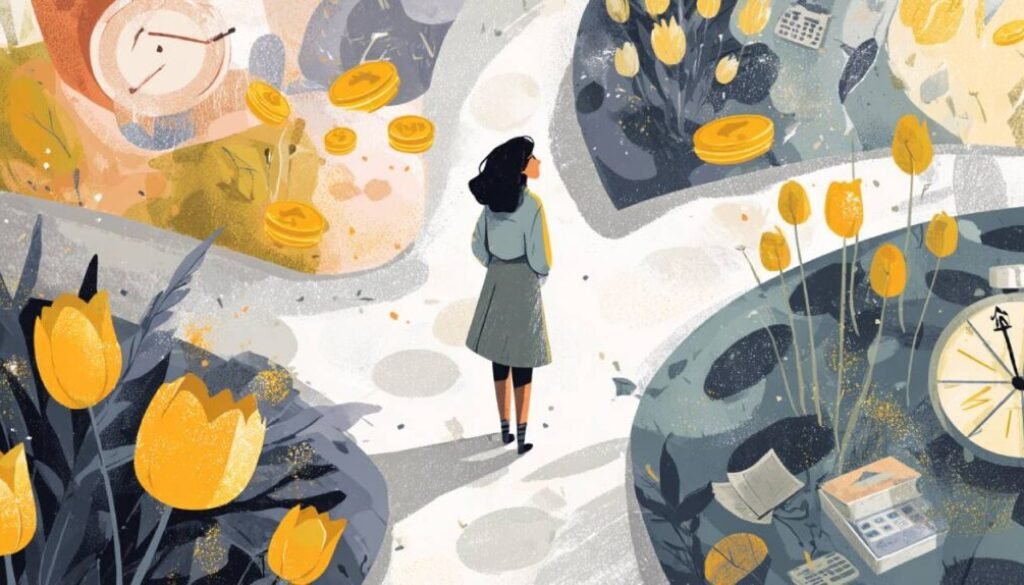Soft Saving: Why Gen Z Chooses Joy Over Saving
In a world where financial advice often screams “save more, spend less,” a quiet rebellion is gaining momentum — and it’s called Soft Saving. Unlike traditional money strategies that glorify aggressive saving and delayed gratification, Soft Saving is about striking a balance: securing your future without sacrificing your present. Especially among Gen Z, this approach isn’t laziness — it’s a deliberate shift in values. With economic uncertainty, mental health concerns, and rising living costs, more young adults are choosing to prioritize joy, flexibility, and well-being today — even if it means retiring later. But does Soft Saving actually work, or is it just lifestyle branding in disguise? Let’s break it down.

Chapter 1: What Is Soft Saving — And Why It’s Shaping Gen Z’s Financial Future
Soft Saving is more than a trending term — it’s a mindset shift. Rather than chasing extreme frugality or trying to retire by 35, Soft Saving emphasizes financial sustainability paired with emotional fulfillment. In essence, it’s about saving smart without sacrificing your life for your savings account.
Compared to traditional models like FIRE (Financial Independence, Retire Early), where every dollar is funneled into long-term investment accounts, Soft Saving encourages balance. You save some, spend meaningfully, and live now. For Gen Z especially, this shift isn’t just a rebellion — it’s a survival strategy. With inflation, burnout, and skyrocketing rent shaping their reality, many are choosing to prioritize mental wellness over financial anxiety.
💡 Example: Instead of skipping that weekend trip to save $200, a soft saver might still go — but use cashback apps, budget it in advance, or book a modest hotel. They’re saving differently, not less.
Why This Matters More Than Ever
According to recent data, over 73% of Gen Z prefer enjoying their money today rather than hoarding it for an uncertain future. Despite this, 84% still save monthly — though they do so with more flexible, value-driven goals.
This shift shows that wealth is being redefined. It’s no longer just about accumulation. Instead, it’s about how money enhances your daily life. If you want to explore this idea further, check out our internal guide:
🔗 What Money Really Buys: Wealth vs Happiness
And if you’re wondering where to begin, this free wealth mindset blueprint gives you real tools to align your money with your purpose — without guilt, stress, or burnout.
From Scarcity to Soft Strength
Beyond numbers, Soft Saving represents a deeper transformation — a shift from scarcity thinking to what many now call an abundance mindset. Importantly, it doesn’t mean abandoning discipline. Rather, it’s about applying discipline in a way that doesn’t destroy your joy.
🎥 Want to see this in action?
Watch this 30-second video to see how Gen Z is reshaping wealth norms through small, intentional choices.
✅ Relevant Reads to Deepen This Topic
📌 Recommended Action
If you’re done with the stress of all-or-nothing saving, it’s time to shift gears. Grab the free Soft Saving playbook and start building a life of financial intention — without going broke to do it.

Chapter 2: Why Soft Saving Matters in 2025 (And Beyond)
In a time of uncertainty, Soft Saving has evolved beyond a trendy lifestyle choice — it’s a direct response to a rapidly shifting world. The economy no longer plays by the old rules, and neither do people’s expectations. Gen Z isn’t simply “bad at saving.” Instead, they’re actively redefining what it means to save in an age where mental health, flexibility, and financial survival often take priority over long-term accumulation.
The Reality Gen Z Is Facing
Let’s talk numbers. According to Investopedia, 73% of Gen Z say they’d rather enjoy their money now than postpone gratification for decades. This isn’t recklessness — it’s a response to pressure.
Consider the reality they’re up against:
-
Soaring housing prices and stagnant wages
-
Skyrocketing student loan debt
-
Widespread burnout and mental health struggles
In light of these challenges, it’s no surprise that many young adults are shifting to a more compassionate, adaptive financial strategy — one that meets their emotional and lifestyle needs without sacrificing all future planning.
Importantly, they’re not abandoning saving altogether. In fact, 84% of Gen Z still save money each month, but they do it differently: prioritizing travel, education, wellness, and meaningful experiences over blind accumulation.
🔗 Want to align your money with your values? Start here with this free wealth alignment guide.
Soft Saving vs. Financial Extremes
Soft Saving offers a practical alternative to the FIRE model, which emphasizes aggressive saving and ultra-early retirement. The table below breaks it down clearly:
| FIRE Approach | Soft Saving Approach |
|---|---|
| Save 50–75% of income | Save 10–30% realistically |
| Retire by 35 | Build flexible, life-long income |
| Frugality above all else | Frugality balanced with fulfillment |
| Delay all enjoyment | Enjoy responsibly while building |
This contrast shows why Soft Saving resonates with a generation that values balance over extremism.
🔥 Curious how this compares to wealth-building mindsets? Check out this abundance thinking guide.
What We Can Learn from Soft Savers
The truth is, Soft Savers aren’t ignoring the future — they’re designing it differently. They still budget, invest, and build emergency funds. But they also prioritize joy, health, and purpose along the way.
This generation is leading a hybrid lifestyle where joy funds and safety nets can—and should—coexist.
📽️ Want to see this in practice? Watch this short video showing how Gen Z creators manage money while still living fully.
When you’re ready to stop choosing between financial freedom and personal fulfillment, start your own Soft Saving path with this free guide:
👉 Download the Free Soft Saving Playbook
🔗 Recommended Reads

Chapter 3: Soft Saving by the Numbers — What the Data Tells Us
The rise of Soft Saving isn’t a fluke or a fad — it’s backed by data. While critics may call Gen Z “financially irresponsible,” the numbers tell a very different story. In reality, this generation is saving strategically, spending with intention, and navigating far more complex conditions than previous generations ever faced.
📊 Key Stats That Define the Soft Saving Era
Let’s look at the numbers shaping this financial mindset:
-
84% of Gen Z save money monthly, even while facing inflation and higher living costs
-
57% actively budget and track spending habits
-
Only 1 in 5 have a long-term financial plan — and that’s intentional. Most prefer flexibility over rigid projections
-
68% prioritize mental well-being when making money decisions, even if that means saving a little less
These stats reveal a powerful trend: Gen Z isn’t failing at finance — they’re redefining what success looks like.
🎯 Curious how emotions influence your money habits? Dive into this powerful guide on financial fulfillment vs traditional success
📈 A Visual Look at Soft Saving Trends
(This is a great place to insert a pie chart or infographic showing the 84% savings rate, 57% budgeters, and 68% mental health prioritizers.)
This behavior reflects a fundamental value shift, not financial laziness. Gen Z wants to save for the future without missing the present. They’re not avoiding discipline — they’re avoiding burnout.
📉 Old-school financial models assumed stable jobs, affordable homes, and predictable markets. But for today’s young adults, those assumptions no longer hold. That’s why Soft Saving is not just smart — it’s necessary.
🔗 Want to build realistic wealth goals without hustle culture? → Download the Free Soft Saving Playbook
🔍 Internal Reflection: Are You Soft Saving — or Just Avoiding Saving?
Ask yourself:
✅ Do you know what brings you joy — and budget for it?
✅ Do you have a savings buffer or emergency fund?
✅ Do your financial goals adapt as your life evolves?
If you answered “yes” to two or more, you’re likely already living with a Soft Saving mindset.
Want to align your finances with your values?
📘 Purpose + Wealth: Make Money Work for Your Life Goals
✅ Make the Numbers Work for You
Here’s the real takeaway: Gen Z isn’t rejecting wealth — they’re rebuilding it on their own terms. And the numbers prove it.
➡ Ready to start Soft Saving with structure and purpose?
🌟 Get the Free Soft Saving Playbook and create a system that gives you peace, flexibility, and freedom — not financial stress.

Chapter 4: Soft Saving Benefits & Risks — What You Gain (and What You Might Miss)
No financial strategy is flawless — and Soft Saving is no exception. While it offers a refreshing, balanced approach to money, it also comes with trade-offs. The key lies in maximizing its advantages while avoiding the most common pitfalls.
💎 The Real Benefits of Soft Saving
✅ Mental Clarity & Emotional Relief
One of the biggest perks of Soft Saving is freedom from guilt-driven hustle culture. It gives you space to breathe, slow down, and redirect energy toward both financial wellness and emotional peace of mind.
🔗 Explore the deeper connection between money and happiness →
What Money Really Buys
✅ Life Satisfaction Now
You shouldn’t have to wait until age 60 to enjoy your life. Soft savers plan joy intentionally, setting aside funds for travel, hobbies, and rest — without losing sight of long-term goals.
✅ Flexibility in a Changing World
In today’s uncertain world of layoffs, automation, and economic shifts, rigid 30-year plans can feel useless. Soft Saving allows you to pivot when needed, without sabotaging your financial stability.
✅ Value-Driven Spending
Rather than following social pressure or status games, Soft Saving helps you spend in a way that matches your purpose. Joy-based budgeting, emergency buffers, and mindful spending become tools for alignment — not anxiety.
🔗 Want to make your money match your mission? →
Build Wealth with Purpose
⚠️ The Hidden Risks of Soft Saving
❌ Lack of Compound Growth
If you delay investing, you risk missing out on the power of compounding. Waiting too long could mean working longer or sacrificing freedom later.
📊 Pro Tip: Even soft savers should auto-invest a small percentage into retirement or index funds. Let compound interest work while you live.
❌ Emergency Blind Spots
Joy funds are great, but without an emergency cushion, you’re vulnerable. One surprise bill could undo months of progress if you’re not prepared.
✅ Learn how to build a safety-first Soft Saving plan →
Stewardship Guide
❌ Overspending Disguised as “Self-Care”
Not all spending is healing. Without limits, “self-care” can turn into self-sabotage.
🎯 Solution: Set clear boundaries — for example, no more than 20% of income on non-essentials.
🛠️ Make Soft Saving Work for You — Without the Pitfalls
Soft Saving doesn’t mean saving less — it means saving smarter.
Here’s how to maintain balance and purpose:
-
🔁 Split your income into 3 categories:
Secure (needs), Strategic (investing), Soulful (joy) -
📘 Use frameworks like this wealth growth guide to protect your future
-
📲 Track your money habits using apps, calendar reminders, or bullet journals
💡 Want a shortcut?
Get everything you need — budget templates, mindset shifts, and daily rituals — inside this free starter kit:

Chapter 5: How to Soft Save Smartly — Practical Tips That Actually Work
Soft Saving isn’t about being lazy with money — it’s about being intentional. If you want to enjoy life and build financial security, you need a strategy that balances joy, preparedness, and discipline.
Here’s how to Soft Save smartly — not recklessly.
🔁 1. Use the 3-S Bucket System
Break your income into three flexible “buckets”:
-
Secure – 50–60% → rent, bills, groceries, minimum debt payments
-
Strategic – 20–30% → emergency fund, retirement, passive income
-
Soulful – 10–20% → joy spending: travel, hobbies, mental wellness
This method allows you to enjoy life without wrecking your finances. It also makes your saving routine clear and adaptable.
Want a guided version of this system? Download the full plan here →
👉 Soft Saving Playbook (Free)
📲 2. Automate Everything
One reason Soft Saving fails? Inconsistency. Beat that by automating:
-
A monthly transfer to savings/investments
-
A recurring contribution to a “joy fund”
-
Micro-transfers via apps like Digit, Acorns, or Revolut Vaults
🧠 Automation builds discipline without friction.
🧘 3. Create a Joy Budget — Not Just a Savings Plan
Don’t just budget for rent and bills. Set aside money for experiences that refuel you. Whether it’s dance classes, a weekend trip, or a massage, these moments are what make saving feel worth it.
Explore how to spend in ways that improve your life →
📘 Wealth & Happiness Guide
⚡ 4. Use Visual Anchors to Stay on Track
Vision boards, budgeting journals, and habit tracker apps keep your eyes on your goals. Set a “why” behind every budget line. Is it freedom? Travel? Time?
🎯 Track your progress like this:
✅ Emergency fund goal met → weekend trip
✅ No impulse buys → treat meal
✅ 3 months of auto-saving → new headphones
Get more money-mindset tools here →
📘 10 Wealth Mindsets That Build Generational Riches
🧩 5. Stack Your Strategy with Side Income
Soft Saving works even better with multiple income streams. Use that extra cash to pad your Strategic and Soulful buckets. Ideas:
-
Freelancing
-
Affiliate marketing (like this program)
-
Selling digital products
-
Renting out unused gear
Not sure where to start? →
🚀 7 Ways to Boost Your Income
✨ Bonus: Weekly Check-In Ritual
Every Sunday, ask:
-
What gave me joy this week?
-
Did I move closer to my financial goals?
-
What will I adjust next week?
Keep it simple, honest, and flexible — that’s the spirit of Soft Saving.
🎁 Final Step: Want everything in one place? Budget templates, sample routines, side gig ideas — it’s all inside this free PDF:

Chapter 6: Real-Life Soft Saving Case Studies — How It Works in the Wild
Talking about Soft Saving is helpful — but seeing it in real life makes it real. Fortunately, thousands of people are quietly proving that you can balance financial discipline with genuine joy, starting today.
Below are three case studies (based on composite data and public behavior trends) showing how Soft Saving is helping Gen Z and millennials create lives that are financially responsible — and deeply fulfilling.
🎒 CASE 1: Emma, 27 – Freelance Designer Funding Travel & Retirement
-
Income: $4,200/month (freelance + Etsy shop)
-
Strategy: 60% Secure, 25% Strategic, 15% Soulful
-
Tools used: Auto-savings, budgeting apps, passive Etsy income
Emma contributes 25% of her income to a Roth IRA and index fund portfolio. But she also budgets $500/month into a joy fund for short getaways every 2–3 months.
“I’m not trying to retire early. I’m just trying to avoid burnout while still investing for the long term.”
💡 Her tip: Automate your long-term savings, then intentionally spend the rest on experiences that refill your energy.
➡️ Inspired? Start your own plan with the free Soft Saving Playbook
🧠 CASE 2: Malcolm, 31 – ADHD Entrepreneur Managing Chaos and Cash
-
Income: ~$6,800/month (online coaching + YouTube affiliate income)
-
Strategy: 50% Secure, 30% Strategic, 20% Soulful
-
Tools used: Notion, Acorns, weekly financial check-ins
Malcolm used to struggle with hyperfocus and impulse spending. By connecting joy-based spending with goal tracking, he gained control without losing momentum.
🎯 He celebrates small wins by treating himself — but only after hitting specific financial goals.
🎥 Watch a lifestyle like Malcolm’s in action → YouTube Short
🌱 CASE 3: Aisha & Ben, 34 – Parents Soft Saving to Stay Present
-
Household Income: ~$9,000/month (remote job + side gig)
-
Strategy: 55% Secure, 25% Strategic, 20% Soulful
-
Tools used: Family spreadsheet, high-yield savings, envelope system
Aisha and Ben ditched the guilt of “perfect” financial parenting. Instead, they intentionally budget for low-cost, high-joy family experiences, like weekend hikes and museum trips — all while saving for their children’s future.
“We don’t feel behind anymore — we feel aligned.”
📘 Learn how to apply this mindset to your own life →
Financial Fulfillment: Stewardship Over Sacrifice
💡 Takeaway: Soft Saving Is Flexible, Not Flaky
These stories prove that Soft Saving is a system, not a shortcut. Whether you’re a freelancer, a family builder, or someone managing neurodivergence, this method adapts to your life — not the other way around.
📥 Ready to design your own strategy?
Grab your free Soft Saving starter kit to get practical templates, mindset prompts, and budget blueprints.
✅ Want to Build Your Own Soft Saving Plan?
Here are your next steps:
🎥 Bonus Watch: How Young Adults Are Budgeting with Joy & Freedom

Chapter 7: Soft Saving Starts Now — Final Thoughts + Your Action Plan
By now, it’s clear: Soft Saving isn’t a shortcut — it’s a strategic mindset shift. It’s about choosing intention over impulse, presence over pressure, and clarity over chaos. In a world built for burnout and extremes, this approach gives you permission to live differently.
Whether you’re earning $2,000 or $10,000 a month, the message stays the same:
🧭 Save for your future. But live your life now.
🎯 Action Plan: 5 Steps to Start Soft Saving Today
Let’s turn insight into action. Here’s your starter roadmap:
1. Split Your Income by Purpose
Use the 3‑S System:
-
Secure (needs + basics)
-
Strategic (long-term goals)
-
Soulful (joy + life value)
Budget based on reality, not perfection.
2. Automate Strategic Savings
Set up recurring transfers to:
-
High-yield savings accounts
-
Retirement funds
-
Passive investing apps like Acorns or M1 Finance
Let automation protect your future while you focus on living fully.
3. Build a Joy Fund
Even $50/month can change your mindset. Budget for joy — not guilt-ridden splurges. Plan rest, play, and adventure as a financial priority.
4. Review Weekly
Reflect every Sunday (or any day you choose). Ask:
-
Did I spend in alignment with what I value?
-
Do I feel in control of my money and energy?
-
What needs adjusting?
🧠 Bonus: Journal your wins. Reinforce them with this mindset reflection guide.
5. Commit to Long-Term Fulfillment
Soft Saving is not a one-time fix — it’s a lifelong framework. Your income, goals, and habits will evolve — so will your system. Don’t chase perfection. Chase peace, progress, and purpose.
💬 Final Thought
You don’t have to choose between living well and being financially responsible. With Soft Saving, you finally get both — on your own terms.
📘 Ready to begin?
👉 Download the Free Soft Saving Playbook to get instant access to templates, trackers, and a fresh financial mindset.
🔗 Explore More Tools & Insights
🎥 Bonus Watch: Soft Saving in 60 Seconds






